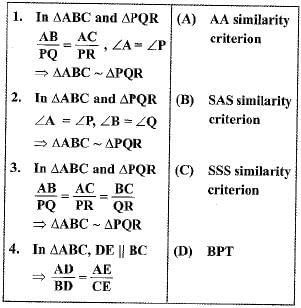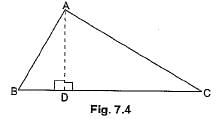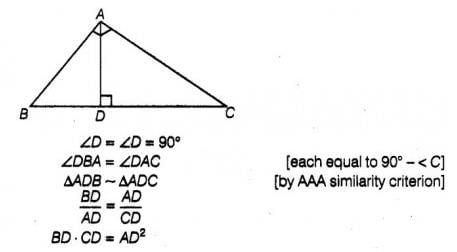All Exams >
Class 10 >
Mathematics Class 10 (Maharashtra SSC Board) >
All Questions
All questions of Similarity for Class 10 Exam
Direction: In the following questions, A statement of Assertion (A) is followed by a statement of Reason (R). Mark the correct choice as.Assertion (A): Corresponding sides of two similar triangles are in the ratio of 2 : 3. If the area of the smaller triangle is 48 cm2, then the area of the larger triangle is 108 cm2.Reason (R): If D is a point on the side BC of a triangle ABC such that ∠ADC = ∠BAC, then CA2 = CB × CD.- a)Both A and R are true and R is the correct explanation of A
- b)Both A and R are true but R is NOT the correct explanation of A
- c)A is true but R is false
- d)A is false and R is True
Correct answer is option 'B'. Can you explain this answer?
Direction: In the following questions, A statement of Assertion (A) is followed by a statement of Reason (R). Mark the correct choice as.
Assertion (A): Corresponding sides of two similar triangles are in the ratio of 2 : 3. If the area of the smaller triangle is 48 cm2, then the area of the larger triangle is 108 cm2.
Reason (R): If D is a point on the side BC of a triangle ABC such that ∠ADC = ∠BAC, then CA2 = CB × CD.
a)
Both A and R are true and R is the correct explanation of A
b)
Both A and R are true but R is NOT the correct explanation of A
c)
A is true but R is false
d)
A is false and R is True
|
|
Krishna Iyer answered |
In case of assertion

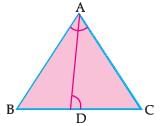
Let ΔABC and ΔDEF are two similar triangles.

Given that ar ΔABC = 48 cm2. Then,

Thus, the area of larger triangle is 108 cm2.
∴ Assertion is correct.
In case of reason:

In ΔBAC and ΔADC,
∠BAC= ∠ADC [Given]
∠BCA= ∠ACD [Common angle]
By AA similarity, ΔBAC ~ ΔADC
Thus,
CA/CD = BC/CA
∴ Reason is correct.
Hence, both assertion and reason are correct but reason is not the correct explanation for assertion.
If  BC = 21 cm, then EF is equal to
BC = 21 cm, then EF is equal to- a)9 cm
- b)6 cm
- c)35 cm
- d)25 cm
Correct answer is option 'C'. Can you explain this answer?
If  BC = 21 cm, then EF is equal to
BC = 21 cm, then EF is equal to
 BC = 21 cm, then EF is equal to
BC = 21 cm, then EF is equal toa)
9 cm
b)
6 cm
c)
35 cm
d)
25 cm

|
Imk Pathshala answered |
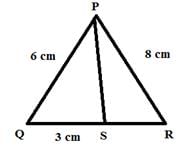
Since, PS is the angle bisector of angle QPR
So, by angle bisector theorem,
QS/SR = PQ/PR
⇒ 3/SR = 6/8
⇒ SR = (3 X 8)/6 cm = 4 cm
It is given that ar(ΔABC) = 81 square units and ar(ΔDEF) = 64 square units. If ΔABC ~ ΔDEF, then- a)AB/DE = 81/64
- b)

- c)AB/DE = 9/8
- d)AB = 81 units, DE = 64 units
Correct answer is option 'C'. Can you explain this answer?
It is given that ar(ΔABC) = 81 square units and ar(ΔDEF) = 64 square units. If ΔABC ~ ΔDEF, then
a)
AB/DE = 81/64
b)

c)
AB/DE = 9/8
d)
AB = 81 units, DE = 64 units

|
Imk Pathshala answered |
In triangle ACB and ADC
∠A=∠A
∠ACB = ∠CDA
Therefore triangle ACB and ADC are similar,
Hence
AC/AD = AB/AC
AC2 = AD X AB
82 = 3 x AB
⇒ AB = 64/3
This implies,
BD = 64/3 – AD
⇒ BD = 55/3
∠A=∠A
∠ACB = ∠CDA
Therefore triangle ACB and ADC are similar,
Hence
AC/AD = AB/AC
AC2 = AD X AB
82 = 3 x AB
⇒ AB = 64/3
This implies,
BD = 64/3 – AD
⇒ BD = 55/3
Which geometric figures are always similar?- a)Circles
- b)Circles and all regular polygons
- c)Circles and triangles
- d)Regular polygons
Correct answer is option 'B'. Can you explain this answer?
Which geometric figures are always similar?
a)
Circles
b)
Circles and all regular polygons
c)
Circles and triangles
d)
Regular polygons
|
|
Raghav Bansal answered |
It can be found that circles map one onto another.So they are similar figures. A regular polygon is a polygon which has the same sides and equal measures of angles. So they are also similar.
In triangle ABC, if AB = 6√3 cm, AC = 12 cm and BC cm, then ∠B is - a)120°
- b)60°
- c)90°
- d)45°
Correct answer is option 'C'. Can you explain this answer?
In triangle ABC, if AB = 6√3 cm, AC = 12 cm and BC cm, then ∠B is
a)
120°
b)
60°
c)
90°
d)
45°
|
|
Gaurav Kumar answered |
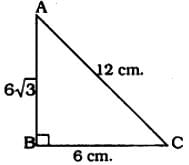
Here largest side is 12 cm.
If the square of the hypotenuse is equal to the square of the other two sides, then it is a right-angled triangle.
If the square of the hypotenuse is equal to the square of the other two sides, then it is a right-angled triangle.
∴ c2 = a2 + b2
AC2 = AB2 + BC2
(12)2 = (63)2 + (6)2
44 = 36 × 3 + 36
144 = 108 + 36
144 = 144
∴ ∆ABC is a right angled triangle and angle opposite to hypotenuse, ∠B = 90°.
ΔABC ~ ΔPQR, ∠B = 50° and ∠C = 70° then ∠P is equal to- a)50°
- b)60°
- c)40°
- d)70°
Correct answer is option 'B'. Can you explain this answer?
ΔABC ~ ΔPQR, ∠B = 50° and ∠C = 70° then ∠P is equal to
a)
50°
b)
60°
c)
40°
d)
70°
|
|
Radha Iyer answered |
Similar triangles have corresponding angles equal. So Angle Q=Angle B = 50° and Angle R = Angle C = 70° . So by angle sum property, Angle P+Angle Q +Angle R = 180°
Angle P=180° - 50° - 70° = 60°
Angle P=180° - 50° - 70° = 60°
Which pair of the given quadrilaterals is similar?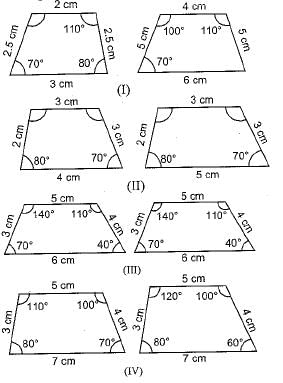
a)I only
b)III onlyc)I and IIId)IVCorrect answer is option 'C'. Can you explain this answer?

|
|
Naina Sharma answered |
Quadrilaterals are similar if their angles are equal and corresponding sides are proportional.
Two congruent triangles are actually similar triangles with the ratio of corresponding sides as.- a)1:2
- b)1:1
- c)1:3
- d)2:1
Correct answer is option 'B'. Can you explain this answer?
Two congruent triangles are actually similar triangles with the ratio of corresponding sides as.
a)
1:2
b)
1:1
c)
1:3
d)
2:1
|
|
Pushkar tiwari answered |
Similar Triangles and Corresponding Sides
Similar triangles are those triangles that have the same shape but may have different sizes. When two triangles are similar, the corresponding angles are the same, and the corresponding sides are proportional. In other words, the ratio of the lengths of the corresponding sides is the same for all pairs of corresponding sides. This ratio is called the scale factor.
Given the statement that "Two congruent triangles are actually similar triangles with the ratio of corresponding sides as," we are asked to determine the scale factor for the corresponding sides of the two triangles.
Option B is the correct answer, and the scale factor is 1:1. This means that the corresponding sides of the two triangles are equal in length.
Explanation of Other Options:
a) 1:2 - This means that the corresponding sides of one triangle are twice as long as the corresponding sides of the other triangle. Therefore, the triangles are not congruent, but they are similar.
c) 1:3 - This means that the corresponding sides of one triangle are three times as long as the corresponding sides of the other triangle. Therefore, the triangles are not congruent, but they are similar.
d) 2:1 - This means that the corresponding sides of one triangle are half as long as the corresponding sides of the other triangle. Therefore, the triangles are not congruent, but they are similar.
Conclusion:
In summary, when two triangles are congruent, they are also similar with a scale factor of 1:1. This means that the corresponding sides of the triangles are equal in length.
Similar triangles are those triangles that have the same shape but may have different sizes. When two triangles are similar, the corresponding angles are the same, and the corresponding sides are proportional. In other words, the ratio of the lengths of the corresponding sides is the same for all pairs of corresponding sides. This ratio is called the scale factor.
Given the statement that "Two congruent triangles are actually similar triangles with the ratio of corresponding sides as," we are asked to determine the scale factor for the corresponding sides of the two triangles.
Option B is the correct answer, and the scale factor is 1:1. This means that the corresponding sides of the two triangles are equal in length.
Explanation of Other Options:
a) 1:2 - This means that the corresponding sides of one triangle are twice as long as the corresponding sides of the other triangle. Therefore, the triangles are not congruent, but they are similar.
c) 1:3 - This means that the corresponding sides of one triangle are three times as long as the corresponding sides of the other triangle. Therefore, the triangles are not congruent, but they are similar.
d) 2:1 - This means that the corresponding sides of one triangle are half as long as the corresponding sides of the other triangle. Therefore, the triangles are not congruent, but they are similar.
Conclusion:
In summary, when two triangles are congruent, they are also similar with a scale factor of 1:1. This means that the corresponding sides of the triangles are equal in length.
If ΔABC ~ ΔEDF then which of the following is not true?
- a)BC . EF = AC . FD
- b)AB . EF = AC . DE
- c)BC . DE = AB . EF
- d)BC . DE = AB . FD
Correct answer is option 'C'. Can you explain this answer?
If ΔABC ~ ΔEDF then which of the following is not true?
a)
BC . EF = AC . FD
b)
AB . EF = AC . DE
c)
BC . DE = AB . EF
d)
BC . DE = AB . FD
|
|
Anita Menon answered |
Since △ABC~△EDF
Then, AB/ED = BC/DF = AC/EF
A) BC/DF = AC/EF
⇒BC.EF=AC.FD
So, A) is true
B) AB/ED = AC/EF
⇒AB.EF=AC.DE
So,B) is true
D) AB/ED = BC/DF
BC.DE=AB.EF
So, D) is not true
Therefore, Option C is not true
In triangles ABC and DEF, ∠B = ∠E, ∠F = ∠C and AB = 3DE. Then, the two triangles are- a)congruent but not similar
- b)similar but not congruent
- c)neither congruent nor similar
- d)congruent as well as similar
Correct answer is option 'B'. Can you explain this answer?
In triangles ABC and DEF, ∠B = ∠E, ∠F = ∠C and AB = 3DE. Then, the two triangles are
a)
congruent but not similar
b)
similar but not congruent
c)
neither congruent nor similar
d)
congruent as well as similar
|
|
Kiran Mehta answered |
to be congruent, the conditions are
S S S - three sides
S A S - two sides and the included angle
A S A - two angles and one side
R H S - R H S - Right angle, Hypotenuse and one side
But to be similar,
A A A means 3 angles
A A means only two angles ....
in both triangles should be equal.
In the problem, equality of two angles is given, but equality of sides is not given.
So, given triangles are not congruent.
But they are similar.
S S S - three sides
S A S - two sides and the included angle
A S A - two angles and one side
R H S - R H S - Right angle, Hypotenuse and one side
But to be similar,
A A A means 3 angles
A A means only two angles ....
in both triangles should be equal.
In the problem, equality of two angles is given, but equality of sides is not given.
So, given triangles are not congruent.
But they are similar.
In the given figure, AD/BD = AE/EC and ∠ADE = 70°, ∠BAC = 50°, then angle ∠BCA =

- a)70°
- b)50°
- c)80°
- d)60°
Correct answer is option 'D'. Can you explain this answer?
In the given figure, AD/BD = AE/EC and ∠ADE = 70°, ∠BAC = 50°, then angle ∠BCA =


a)
70°
b)
50°
c)
80°
d)
60°
|
|
Trisha sharma answered |
Explanation: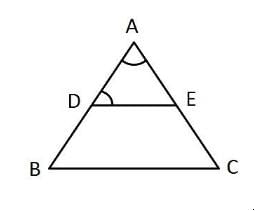
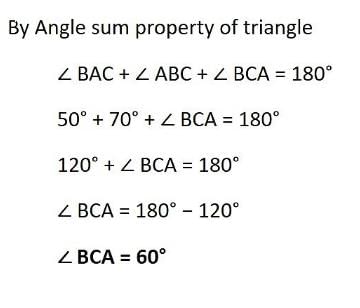

By converse of Thale’s theorem DE II BC
∠ADE = ∠ABC = 70 degree
Given ∠BAC = 50 degree

You can read Important Definitions & Formulas related to Triangles through the document:
In ΔLMN and ΔPQR, ∠L = ∠P, ∠N = ∠R and MN = 2QR. Then the two triangles are- a)Congruent but not similar
- b)Similar but not congruent
- c)neither congruent nor similar
- d)Congrunt as well as similar
Correct answer is option 'B'. Can you explain this answer?
In ΔLMN and ΔPQR, ∠L = ∠P, ∠N = ∠R and MN = 2QR. Then the two triangles are
a)
Congruent but not similar
b)
Similar but not congruent
c)
neither congruent nor similar
d)
Congrunt as well as similar

|
EduRev Class 10 answered |
According to question,
ΔABC ~ ΔDEF,
AB = 4 cm, DE = 6 cm, EF = 9 cm and FD = 12 cm,
Therefore,
AB/DE = BC/EF = AC/DF
4/6 = BC/9 = AC/12
⇒ 4/6 = BC/9
⇒ BC = 6 cm
And
4/6 = AC/12
⇒ AC = 8 cm
Perimeter = AB + BC + CA
= 4 + 6 + 8
= 18 cm
ΔABC ~ ΔDEF,
AB = 4 cm, DE = 6 cm, EF = 9 cm and FD = 12 cm,
Therefore,
AB/DE = BC/EF = AC/DF
4/6 = BC/9 = AC/12
⇒ 4/6 = BC/9
⇒ BC = 6 cm
And
4/6 = AC/12
⇒ AC = 8 cm
Perimeter = AB + BC + CA
= 4 + 6 + 8
= 18 cm
D and E are respectively the points on the sides AB and AC of a triangle ABC such that AD = 3 cm, BD = 5 cm, BC = 12.8 cm and DE || BC. Then length of DE (in cm) is- a)4.8 cm
- b)7.6 cm
- c)19.2 cm
- d)2.5 cm
Correct answer is option 'A'. Can you explain this answer?
D and E are respectively the points on the sides AB and AC of a triangle ABC such that AD = 3 cm, BD = 5 cm, BC = 12.8 cm and DE || BC. Then length of DE (in cm) is
a)
4.8 cm
b)
7.6 cm
c)
19.2 cm
d)
2.5 cm
|
|
Meera Rana answered |
GIVEN: In Δ ABC, D and E are points on AB and AC , DE || BC and AD = 2.4 cm, AE = 3.2 cm, DE = 2 cm and BE = 5 cm.
In Δ ADE and Δ ABC,
∠ADE =∠ABC (corresponding angles)
[DE || BC, AB is transversal]
∠AED =∠ACB (corresponding angles)
[DE || BC, AC is transversal]
So, Δ ADE ~ Δ ABC (AA similarity)
Therefore, AD/AB = AE/AC = DE/BC
[In similar triangles corresponding sides are proportional]
AD/AB = DE/BC
2.4/(2.4+DB) = 2/5
2.4 × 5 = 2(2.4+ DB)
12 = 4.8 + 2DB
12 - 4.8 = 2DB
7.2 = 2DB
DB = 7.2/2
DB = 3.6 cm
Similarly, AE/AC = DE/BC
3.2/(3.2+EC) = 2/5
3.2 × 5 = 2(3.2+EC)
16 = 6.4 + 2EC
16 - 6.4 = 2EC
9.6 = 2EC
EC = 9.6/2
EC = 4.8 cm
Hence,BD = 3.6 cm and CE = 4.8 cm.
In Δ ADE and Δ ABC,
∠ADE =∠ABC (corresponding angles)
[DE || BC, AB is transversal]
∠AED =∠ACB (corresponding angles)
[DE || BC, AC is transversal]
So, Δ ADE ~ Δ ABC (AA similarity)
Therefore, AD/AB = AE/AC = DE/BC
[In similar triangles corresponding sides are proportional]
AD/AB = DE/BC
2.4/(2.4+DB) = 2/5
2.4 × 5 = 2(2.4+ DB)
12 = 4.8 + 2DB
12 - 4.8 = 2DB
7.2 = 2DB
DB = 7.2/2
DB = 3.6 cm
Similarly, AE/AC = DE/BC
3.2/(3.2+EC) = 2/5
3.2 × 5 = 2(3.2+EC)
16 = 6.4 + 2EC
16 - 6.4 = 2EC
9.6 = 2EC
EC = 9.6/2
EC = 4.8 cm
Hence,BD = 3.6 cm and CE = 4.8 cm.
If in triangles ABC and DEF, AB/EF = AC/DE, then they will be similar when- a)∠A = ∠D
- b)∠A = ∠E
- c)∠B = ∠E
- d)∠C = ∠F
Correct answer is option 'B'. Can you explain this answer?
If in triangles ABC and DEF, AB/EF = AC/DE, then they will be similar when
a)
∠A = ∠D
b)
∠A = ∠E
c)
∠B = ∠E
d)
∠C = ∠F

|
Crafty Classes answered |
The altitude divides the opposite side into two equal parts,
Therefore, BD = DC = 4 cm
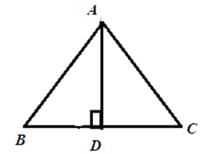
In triangle ABD
AB2 = AD2 + BD2
82 = AD2 + 42
AD2 = 64 – 16
AD2 = 48
AD = 4√3 cm
Therefore, BD = DC = 4 cm

In triangle ABD
AB2 = AD2 + BD2
82 = AD2 + 42
AD2 = 64 – 16
AD2 = 48
AD = 4√3 cm
A square and a rhombus are always - a)similar
- b)congruent
- c)similar but not congruent
- d)neither similar nor congruent
Correct answer is option 'D'. Can you explain this answer?
A square and a rhombus are always
a)
similar
b)
congruent
c)
similar but not congruent
d)
neither similar nor congruent

|
Kamna Science Academy answered |
Let AC be the ladder of length 5m and BC = 4m be the height of the wall where ladder is placed. If the foot of the ladder is moved 1.6m towards the wall i.e. AD = 1.6 m, then the ladder is slided upward to position E i.e. CE = x m.
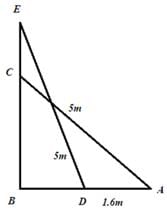
In right triangle ABC
AC2 = AB2 + BC2
⇒52 = AB2 + 42
⇒ AB = 3m
⇒ DB = AB – AD = 3 – 1.6 = 1.4m
In right angled ΔEBD
ED2 = EB2 + BD2
⇒ 52 = EB2 + (1.4)2
⇒ EB = 4.8m
EC = EB – BC = 4.8 – 4 = 0.8m

In right triangle ABC
AC2 = AB2 + BC2
⇒52 = AB2 + 42
⇒ AB = 3m
⇒ DB = AB – AD = 3 – 1.6 = 1.4m
In right angled ΔEBD
ED2 = EB2 + BD2
⇒ 52 = EB2 + (1.4)2
⇒ EB = 4.8m
EC = EB – BC = 4.8 – 4 = 0.8m
In right triangle ABC, right angled at A,A perpendicular is dropped from A to BC, meeting BC at D. Then which of the following is true?- a)ΔADC ~ ΔABD
- b)ΔDCA ~ ΔDABD
- c)ΔDAC ~ ΔDABD
- d)ΔDAC ~ ΔDABA
Correct answer is option 'D'. Can you explain this answer?
In right triangle ABC, right angled at A,
A perpendicular is dropped from A to BC, meeting BC at D. Then which of the following is true?
a)
ΔADC ~ ΔABD
b)
ΔDCA ~ ΔDABD
c)
ΔDAC ~ ΔDABD
d)
ΔDAC ~ ΔDABA
|
|
Naina kapoor answered |
Explanation:
- Let's draw the diagram first.
- From the diagram, we can see that triangle ABD and triangle ACD are both right triangles.
- Therefore, we can use the Pythagorean theorem to find their sides.
- Let's assume that AB = b, AC = c, and BC = a.
- Using Pythagorean theorem, we get:
- AB² + BD² = AD² (for triangle ABD)
- AC² + CD² = AD² (for triangle ACD)
- BC² = AB² + AC² (by Pythagoras theorem)
- Now, we can simplify the above equations to get:
- BD² = AD² - AB² = (AC² + CD²) - AB²
- CD² = AD² - AC² = (AB² + BD²) - AC²
- Substituting the value of BD² and CD² in the above equations, we get:
- AB² + (AC² + CD² - AB²) = AD²
- AC² + (AB² + BD² - AC²) = AD²
- After simplifying, we get:
- AC² = AD² - AB²
- AB² = AD² - AC²
- Therefore, we can say that triangle DAC is similar to triangle DAB by the Angle-Angle-Similarity criterion.
- Thus, option D is the correct answer.
In the given fig, P and Q are points on the sides AB and AC respectively of Δ ABC such that AP = 3.5 cm, PB = 7 cm, AQ = 3 cm and QC = 6 cm. If PQ = 4.5 cm, find BC.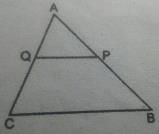
- a)13.5 cme
- b)2. 6 cm
- c)3.4 cm
- d)1. 6 cm
Correct answer is option 'A'. Can you explain this answer?
In the given fig, P and Q are points on the sides AB and AC respectively of Δ ABC such that AP = 3.5 cm, PB = 7 cm, AQ = 3 cm and QC = 6 cm. If PQ = 4.5 cm, find BC.

a)
13.5 cme
b)
2. 6 cm
c)
3.4 cm
d)
1. 6 cm

|
Rahul Kumar answered |

Therefore, by converse of Basic Proportionality Theorem, we have QP || CB
Hence, ∆AQP ~ ∆ACB [Using AA similar condition]
∴ 
⇒
⇒

⇒

⇒

If ΔPRQ ~ ΔXYZ, then- a)

- b)

- c)

- d)

Correct answer is option 'C'. Can you explain this answer?
If ΔPRQ ~ ΔXYZ, then
a)

b)

c)

d)

|
|
Kuldeep Kuldeep answered |
Since the two triangles are similar, therefore, they will have their corresponding angles congruent and the corresponding sides in proportion.
Direction: In the following questions, A statement of Assertion (A) is followed by a statement of Reason (R). Mark the correct choice as.Assertion : ABC is an isosceles, right triangle, right angled at C . Then AB2 = 3AC2Reason : In an isosceles triangle ABC if AC = BC and AB2 = 2AC2 , then ∠C = 90°- a)Both A and R are true and R is the correct explanation of A
- b)Both A and R are true but R is NOT the correct explanation of A
- c)A is true but R is false
- d)A is false and R is True
Correct answer is option 'D'. Can you explain this answer?
Direction: In the following questions, A statement of Assertion (A) is followed by a statement of Reason (R). Mark the correct choice as.
Assertion : ABC is an isosceles, right triangle, right angled at C . Then AB2 = 3AC2
Reason : In an isosceles triangle ABC if AC = BC and AB2 = 2AC2 , then ∠C = 90°
a)
Both A and R are true and R is the correct explanation of A
b)
Both A and R are true but R is NOT the correct explanation of A
c)
A is true but R is false
d)
A is false and R is True
|
|
Ishan Choudhury answered |
If Assertion is incorrect, but Reason is correct.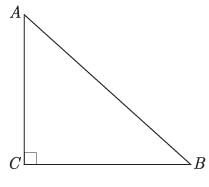
In right angled ΔABC ,

AB2 = AC2 + BC2(By Pythagoras Theorem)
= AC2 + AC2 [BC = AC]
= 2AC2AB2 = 2AC2
Assertion is false.
Again since, AB2 = 2AC2
= AC2 + AC2 = AC2 + BC2 (AC = BC given)
∠ = 90°
(By converse of Pythagoras Theorem)Reason is true.
Direction: In the following questions, A statement of Assertion (A) is followed by a statement of Reason (R). Mark the correct choice as.Assertion : The length of the side of a square whose diagonal is 16 cm, is 8√2 cmReason : In a right triangle, the square of the hypotenuse is equal to the sum of the squares of the other two sides.- a)Both A and R are true and R is the correct explanation of A
- b)Both A and R are true but R is NOT the correct explanation of A
- c)A is true but R is false
- d)A is false and R is True
Correct answer is option 'A'. Can you explain this answer?
Direction: In the following questions, A statement of Assertion (A) is followed by a statement of Reason (R). Mark the correct choice as.
Assertion : The length of the side of a square whose diagonal is 16 cm, is 8√2 cm
Reason : In a right triangle, the square of the hypotenuse is equal to the sum of the squares of the other two sides.
a)
Both A and R are true and R is the correct explanation of A
b)
Both A and R are true but R is NOT the correct explanation of A
c)
A is true but R is false
d)
A is false and R is True
|
|
Meera Rana answered |
We know that In a right triangle, the square of the hypotenuse is equal to the sum of the squares of the other two sides. This is Pythagoras theorem. So, Reason is correct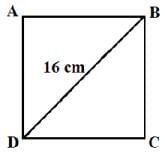

Let the side of square be x cm.
In ∆ABD, by Pythagoras theorem, we have BD2 = AB2 + AD2
⇒ 162 = x2 + x2
⇒ 2x2 = 256 ⇒ x2 = 128 ⇒ x = 8√2 cm
So, Assertion is also correct.
Sides of triangles are (i) 3 cm, 4 cm, 6 cm. (ii) 4 cm, 5 cm, 6 cm. (iii) 7 cm, 24 cm, 25 cm (iv) 5 cm, 10 cm, 14 cm. Which of these is right triangle?
- a)(i)
- b)(ii)
- c)(iii)
- d)(iv)
Correct answer is option 'C'. Can you explain this answer?
Sides of triangles are (i) 3 cm, 4 cm, 6 cm. (ii) 4 cm, 5 cm, 6 cm. (iii) 7 cm, 24 cm, 25 cm (iv) 5 cm, 10 cm, 14 cm. Which of these is right triangle?
a)
(i)
b)
(ii)
c)
(iii)
d)
(iv)
|
|
Radha Iyer answered |
On verification, triangle with sides 7 cm, 24 cm and 25 cm is a right triangle
∵ (25)2 = (7)2 + (24)2.
∵ (25)2 = (7)2 + (24)2.
Direction: In the following questions, A statement of Assertion (A) is followed by a statement of Reason (R). Mark the correct choice as.Assertion (A): If in two right triangles, one of the acute angles of one triangle is equal to an acute angle of the other triangle, then triangles will be similar.Reason (R): If the ratio of the corresponding altitudes of two similar triangles is 3/5, then theratio of their areas is 6/5.- a)Both A and R are true and R is the correct explanation of A
- b)Both A and R are true but R is NOT the correct explanation of A
- c)A is true but R is false
- d)A is false and R is True
Correct answer is option 'C'. Can you explain this answer?
Direction: In the following questions, A statement of Assertion (A) is followed by a statement of Reason (R). Mark the correct choice as.
Assertion (A): If in two right triangles, one of the acute angles of one triangle is equal to an acute angle of the other triangle, then triangles will be similar.
Reason (R): If the ratio of the corresponding altitudes of two similar triangles is 3/5, then the
ratio of their areas is 6/5.
a)
Both A and R are true and R is the correct explanation of A
b)
Both A and R are true but R is NOT the correct explanation of A
c)
A is true but R is false
d)
A is false and R is True
|
|
Meera Rana answered |
In case of assertion: In the given two right triangles, both have equal right angles and one of the acute angles of one triangle is equal to an acute angle of the other triangle.
Thus, by AA similarity, the given two triangles are similar.
∴ Assertion is correct.
In case of reason:
We know that the ratio of the areas of two similar triangles is the square of the ratio of the corresponding altitudes of two similar triangles.
Thus, the ratio of the areas of two similar triangles is (3/5)2 = 9/25.
The length of each side of a rhombus whose diagonals are of lengths 10 cm and 24 cm is- a)25 cm
- b)13 cm
- c)26 cm
- d)34 cm
Correct answer is option 'B'. Can you explain this answer?
The length of each side of a rhombus whose diagonals are of lengths 10 cm and 24 cm is
a)
25 cm
b)
13 cm
c)
26 cm
d)
34 cm

|
Crafty Classes answered |
Since O is the point of intersection of two equal chords AB and CD such that OB = OD,
As chords are equal and OB = OD, so AO will also be equal to OC
Also ∠AOC = ∠DOB = 450
Now in triangles OAC and ODB
AO/OB = CO/OD
And ∠AOC = ∠DOB = 450
So triangles are isosceles and similar.
As chords are equal and OB = OD, so AO will also be equal to OC
Also ∠AOC = ∠DOB = 450
Now in triangles OAC and ODB
AO/OB = CO/OD
And ∠AOC = ∠DOB = 450
So triangles are isosceles and similar.
Direction: In the following questions, A statement of Assertion (A) is followed by a statement of Reason (R). Mark the correct choice as.
Assertion (A): In an equilateral triangle of side 3√3 cm, then the length of the altitude is 4.5 cm.
Reason (R): If a ladder 10 cm long reaches a window 8 cm above the ground, then the distance of the foot of the ladder from the base of the wall is 6 cm.
- a)Both A and R are true and R is the correct explanation of A
- b)Both A and R are true but R is NOT the correct explanation of A
- c)A is true but R is false
- d)A is false and R is True
Correct answer is option 'B'. Can you explain this answer?
Direction: In the following questions, A statement of Assertion (A) is followed by a statement of Reason (R). Mark the correct choice as.
Assertion (A): In an equilateral triangle of side 3√3 cm, then the length of the altitude is 4.5 cm.
Reason (R): If a ladder 10 cm long reaches a window 8 cm above the ground, then the distance of the foot of the ladder from the base of the wall is 6 cm.
a)
Both A and R are true and R is the correct explanation of A
b)
Both A and R are true but R is NOT the correct explanation of A
c)
A is true but R is false
d)
A is false and R is True
|
|
Nandini shah answered |
Assertion (A): In an equilateral triangle of side 3√3 cm, the length of the altitude is 4.5 cm.
Reason (R): If a ladder 10 cm long reaches a window 8 m above the ground, then the distance of the foot of the ladder from the base of the wall is 6 m.
To determine the correctness of the Assertion (A) and the Reason (R), let's analyze each statement separately.
Assertion (A): In an equilateral triangle of side 3√3 cm, the length of the altitude is 4.5 cm.
To find the length of the altitude in an equilateral triangle, we can use the formula:
Altitude = (sqrt(3)/2) * side length
Given that the side length of the equilateral triangle is 3√3 cm, we can substitute this value into the formula:
Altitude = (sqrt(3)/2) * 3√3
= (sqrt(3)/2) * 3 * √3
= (sqrt(3)/2) * 3 * √(3^2)
= (sqrt(3)/2) * 3 * 3
= (sqrt(3)/2) * 9
= 9√3/2
Simplifying further, we get:
Altitude = 4.5√3 cm
Therefore, Assertion (A) is true.
Reason (R): If a ladder 10 cm long reaches a window 8 m above the ground, then the distance of the foot of the ladder from the base of the wall is 6 m.
To understand this reason, we can consider a right-angled triangle formed by the ladder, the distance of the foot of the ladder from the base of the wall, and the height of the window.
Let the distance of the foot of the ladder from the base of the wall be x meters. According to the given information, the ladder is 10 m long and reaches a window 8 m above the ground. Using the Pythagorean theorem, we can establish the following relationship:
x^2 + 8^2 = 10^2
x^2 + 64 = 100
x^2 = 100 - 64
x^2 = 36
x = √36
x = 6
Therefore, the distance of the foot of the ladder from the base of the wall is 6 m.
After analyzing both the Assertion (A) and the Reason (R), we can conclude that both A and R are true, and R is the correct explanation of A. Hence, the correct answer is option B.
Reason (R): If a ladder 10 cm long reaches a window 8 m above the ground, then the distance of the foot of the ladder from the base of the wall is 6 m.
To determine the correctness of the Assertion (A) and the Reason (R), let's analyze each statement separately.
Assertion (A): In an equilateral triangle of side 3√3 cm, the length of the altitude is 4.5 cm.
To find the length of the altitude in an equilateral triangle, we can use the formula:
Altitude = (sqrt(3)/2) * side length
Given that the side length of the equilateral triangle is 3√3 cm, we can substitute this value into the formula:
Altitude = (sqrt(3)/2) * 3√3
= (sqrt(3)/2) * 3 * √3
= (sqrt(3)/2) * 3 * √(3^2)
= (sqrt(3)/2) * 3 * 3
= (sqrt(3)/2) * 9
= 9√3/2
Simplifying further, we get:
Altitude = 4.5√3 cm
Therefore, Assertion (A) is true.
Reason (R): If a ladder 10 cm long reaches a window 8 m above the ground, then the distance of the foot of the ladder from the base of the wall is 6 m.
To understand this reason, we can consider a right-angled triangle formed by the ladder, the distance of the foot of the ladder from the base of the wall, and the height of the window.
Let the distance of the foot of the ladder from the base of the wall be x meters. According to the given information, the ladder is 10 m long and reaches a window 8 m above the ground. Using the Pythagorean theorem, we can establish the following relationship:
x^2 + 8^2 = 10^2
x^2 + 64 = 100
x^2 = 100 - 64
x^2 = 36
x = √36
x = 6
Therefore, the distance of the foot of the ladder from the base of the wall is 6 m.
After analyzing both the Assertion (A) and the Reason (R), we can conclude that both A and R are true, and R is the correct explanation of A. Hence, the correct answer is option B.
Direction: In the following questions, A statement of Assertion (A) is followed by a statement of Reason (R). Mark the correct choice as.Assertion : In the ΔABC , AB = 24 cm , BC = 10 cm and AC = 26 cm , then ΔABC is a right angle triangle.Reason : If in two triangles, their corresponding angles are equal, then the triangles are similar.- a)Both A and R are true and R is the correct explanation of A
- b)Both A and R are true but R is NOT the correct explanation of A
- c)A is true but R is false
- d)A is false and R is True
Correct answer is option 'B'. Can you explain this answer?
Direction: In the following questions, A statement of Assertion (A) is followed by a statement of Reason (R). Mark the correct choice as.
Assertion : In the ΔABC , AB = 24 cm , BC = 10 cm and AC = 26 cm , then ΔABC is a right angle triangle.
Reason : If in two triangles, their corresponding angles are equal, then the triangles are similar.
a)
Both A and R are true and R is the correct explanation of A
b)
Both A and R are true but R is NOT the correct explanation of A
c)
A is true but R is false
d)
A is false and R is True
|
|
Kiran Mehta answered |
We have, AB2 + BC2 = (24)2 + (10)2
= 576 + 100 = 676 = 2
AB2 + BC2 = AC2
ABC is a right angled triangle.
Also, two triangle are similar if their corresponding angles are equal.
So, both A and R are correct but R does not explain A.
Direction: In the following questions, A statement of Assertion (A) is followed by a statement of Reason (R). Mark the correct choice as.Assertion : The areas of two similar triangles ABC and PQR are in the ratio 9 :16. If BC = 4.5 cm, then the length of QR is 6 cm.Reason : The ratio of the areas of two similar triangles is equal to the ratio of their corresponding sides.- a)Both A and R are true and R is the correct explanation of A
- b)Both A and R are true but R is NOT the correct explanation of A
- c)A is true but R is false
- d)A is false and R is True
Correct answer is option 'C'. Can you explain this answer?
Direction: In the following questions, A statement of Assertion (A) is followed by a statement of Reason (R). Mark the correct choice as.
Assertion : The areas of two similar triangles ABC and PQR are in the ratio 9 :16. If BC = 4.5 cm, then the length of QR is 6 cm.
Reason : The ratio of the areas of two similar triangles is equal to the ratio of their corresponding sides.
a)
Both A and R are true and R is the correct explanation of A
b)
Both A and R are true but R is NOT the correct explanation of A
c)
A is true but R is false
d)
A is false and R is True

|
Bibek Goyal answered |
Assertion: The areas of two similar triangles ABC and PQR are in the ratio 9:16. If BC = 4.5 cm, then the length of QR is 6 cm.
Reason: The ratio of the areas of two similar triangles is equal to the ratio of their corresponding sides.
To understand why option C is the correct answer, let's break down the assertion and reason given in the question.
Understanding the Assertion:
The assertion states that the areas of two similar triangles ABC and PQR are in the ratio 9:16. This means that the ratio of the areas of these triangles is 9/16.
Understanding the Reason:
The reason given states that the ratio of the areas of two similar triangles is equal to the ratio of their corresponding sides. In other words, if two triangles are similar, then the ratio of their areas is equal to the ratio of the squares of their corresponding sides.
Explanation:
Let's assume that the lengths of the corresponding sides of the triangles ABC and PQR are in the ratio of x:y. Therefore, the ratio of the areas of these triangles will be (x^2):(y^2).
Given that the ratio of the areas of the triangles ABC and PQR is 9:16, we can write the equation as:
(x^2)/(y^2) = 9/16
To find the length of QR, we need to find the value of y. Since we are given that BC = 4.5 cm, we can set up a proportion between the corresponding sides as follows:
BC/PQ = AB/QR
4.5/y = x/y
x = 4.5
Now, substituting the value of x in the equation (x^2)/(y^2) = 9/16, we get:
(4.5^2)/(y^2) = 9/16
20.25/(y^2) = 9/16
Cross-multiplying and solving for y, we get:
16 * 20.25 = 9 * (y^2)
324 = 9 * (y^2)
y^2 = 324/9
y^2 = 36
y = 6
Therefore, the length of QR is 6 cm.
Conclusion:
From the explanation above, it is clear that the assertion and reason are both true. However, the reason does not correctly explain the assertion because it only states the general concept of the ratio of areas of similar triangles being equal to the ratio of their corresponding sides, without specifically addressing the given scenario. Hence, option C is the correct answer.
Reason: The ratio of the areas of two similar triangles is equal to the ratio of their corresponding sides.
To understand why option C is the correct answer, let's break down the assertion and reason given in the question.
Understanding the Assertion:
The assertion states that the areas of two similar triangles ABC and PQR are in the ratio 9:16. This means that the ratio of the areas of these triangles is 9/16.
Understanding the Reason:
The reason given states that the ratio of the areas of two similar triangles is equal to the ratio of their corresponding sides. In other words, if two triangles are similar, then the ratio of their areas is equal to the ratio of the squares of their corresponding sides.
Explanation:
Let's assume that the lengths of the corresponding sides of the triangles ABC and PQR are in the ratio of x:y. Therefore, the ratio of the areas of these triangles will be (x^2):(y^2).
Given that the ratio of the areas of the triangles ABC and PQR is 9:16, we can write the equation as:
(x^2)/(y^2) = 9/16
To find the length of QR, we need to find the value of y. Since we are given that BC = 4.5 cm, we can set up a proportion between the corresponding sides as follows:
BC/PQ = AB/QR
4.5/y = x/y
x = 4.5
Now, substituting the value of x in the equation (x^2)/(y^2) = 9/16, we get:
(4.5^2)/(y^2) = 9/16
20.25/(y^2) = 9/16
Cross-multiplying and solving for y, we get:
16 * 20.25 = 9 * (y^2)
324 = 9 * (y^2)
y^2 = 324/9
y^2 = 36
y = 6
Therefore, the length of QR is 6 cm.
Conclusion:
From the explanation above, it is clear that the assertion and reason are both true. However, the reason does not correctly explain the assertion because it only states the general concept of the ratio of areas of similar triangles being equal to the ratio of their corresponding sides, without specifically addressing the given scenario. Hence, option C is the correct answer.
Direction: In the following questions, A statement of Assertion (A) is followed by a statement of Reason (R). Mark the correct choice as.Assertion : In ∆ABC , AB = 6√3, AC = 12 cm and BC = 6cm then ∠B = 90°.Reason : If in a triangle, square of one side is equal to the sum of the squares of the other two sides, then the angle opposite the first side is a right angle.- a)Both A and R are true and R is the correct explanation of A
- b)Both A and R are true but R is NOT the correct explanation of A
- c)A is true but R is false
- d)A is false and R is True
Correct answer is option 'A'. Can you explain this answer?
Direction: In the following questions, A statement of Assertion (A) is followed by a statement of Reason (R). Mark the correct choice as.
Assertion : In ∆ABC , AB = 6√3, AC = 12 cm and BC = 6cm then ∠B = 90°.
Reason : If in a triangle, square of one side is equal to the sum of the squares of the other two sides, then the angle opposite the first side is a right angle.
a)
Both A and R are true and R is the correct explanation of A
b)
Both A and R are true but R is NOT the correct explanation of A
c)
A is true but R is false
d)
A is false and R is True
|
|
Naina Sharma answered |
We know that If in a triangle, square of one side is equal to the sum of the squares of the other two sides, then the angle opposite the first side is a right angle. This is converse of Pythagoras theorem.
So, Reason is correct
Now, AB2 = (6√3)2 = 108
AC2 = 122 = 144
and BC2 = 62 = 36
∴ 2 = 2 + 2
By converse of Pythagoras theorem, ∠B = 90°
So, Assertion is also correct.
Direction: In the following questions, A statement of Assertion (A) is followed by a statement of Reason (R). Mark the correct choice as.Assertion (A): If D is a point on side QR of ΔPQR such that PD ⊥ QR, then ΔPQD ~ ΔRPD.Reason (R): In the figure given below, if ∠D = ∠C then ΔADE ~ ΔACB.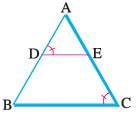
- a)Both A and R are true and R is the correct explanation of A
- b)Both A and R are true but R is NOT the correct explanation of A
- c)A is true but R is false
- d)A is false and R is True
Correct answer is option 'D'. Can you explain this answer?
Direction: In the following questions, A statement of Assertion (A) is followed by a statement of Reason (R). Mark the correct choice as.
Assertion (A): If D is a point on side QR of ΔPQR such that PD ⊥ QR, then ΔPQD ~ ΔRPD.
Reason (R): In the figure given below, if ∠D = ∠C then ΔADE ~ ΔACB.

a)
Both A and R are true and R is the correct explanation of A
b)
Both A and R are true but R is NOT the correct explanation of A
c)
A is true but R is false
d)
A is false and R is True
|
|
Avinash Patel answered |
In case of assertion

In ΔPQD and ΔRPD, ∠PDQ = ∠PDR= 90°.
There is no other information to be similar.
Thus, it is not it will be correct to say that ΔPQD ~ ΔRPD.
∴ Assertion is incorrect.
In case of reason:
In ΔADE and ΔACB, we have
∠ADE= ∠ACB [Given]
∠DAE= ∠CAB [Common angle]
By AA similarity, we get ΔADE ~ ΔACB.
∴ Reason is correct
Hence, assertion is incorrect but reason is correct
Chapter doubts & questions for Similarity - Mathematics Class 10 (Maharashtra SSC Board) 2025 is part of Class 10 exam preparation. The chapters have been prepared according to the Class 10 exam syllabus. The Chapter doubts & questions, notes, tests & MCQs are made for Class 10 2025 Exam. Find important definitions, questions, notes, meanings, examples, exercises, MCQs and online tests here.
Chapter doubts & questions of Similarity - Mathematics Class 10 (Maharashtra SSC Board) in English & Hindi are available as part of Class 10 exam.
Download more important topics, notes, lectures and mock test series for Class 10 Exam by signing up for free.

Contact Support
Our team is online on weekdays between 10 AM - 7 PM
Typical reply within 3 hours
|
Free Exam Preparation
at your Fingertips!
Access Free Study Material - Test Series, Structured Courses, Free Videos & Study Notes and Prepare for Your Exam With Ease

 Join the 10M+ students on EduRev
Join the 10M+ students on EduRev
|

|
Create your account for free
OR
Forgot Password
OR
Signup on EduRev and stay on top of your study goals
10M+ students crushing their study goals daily




